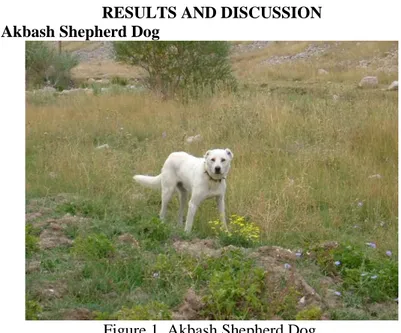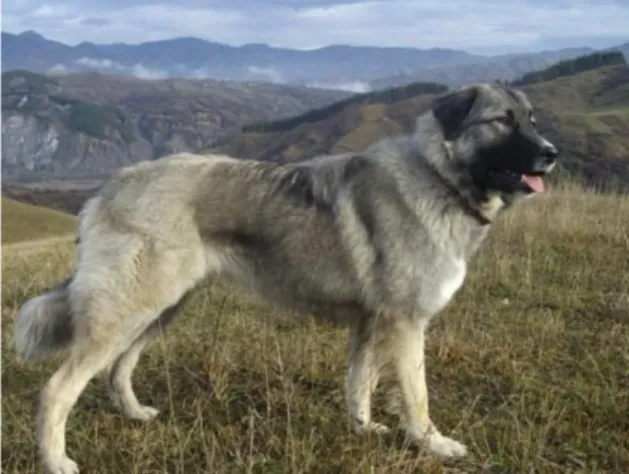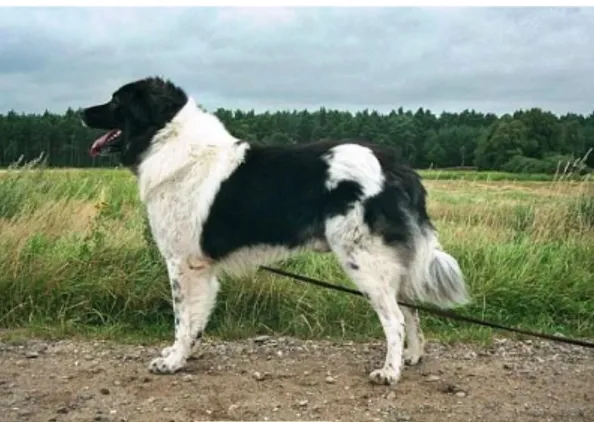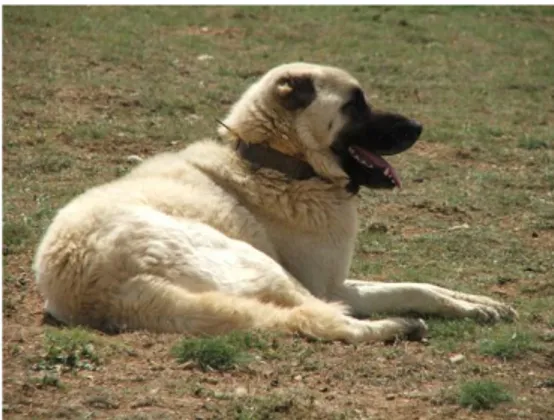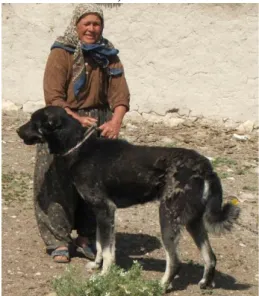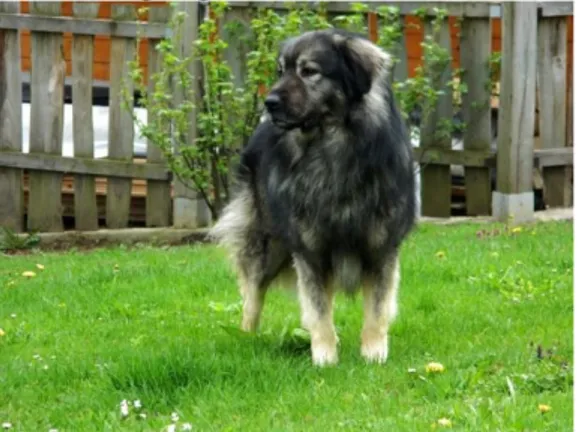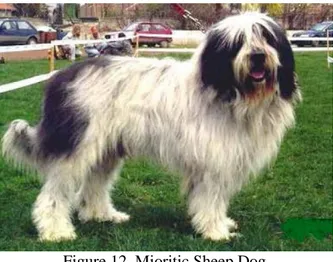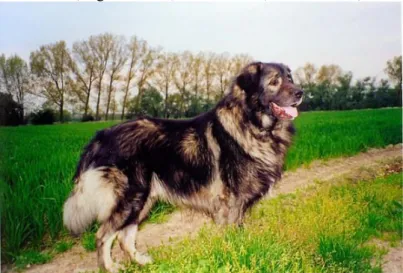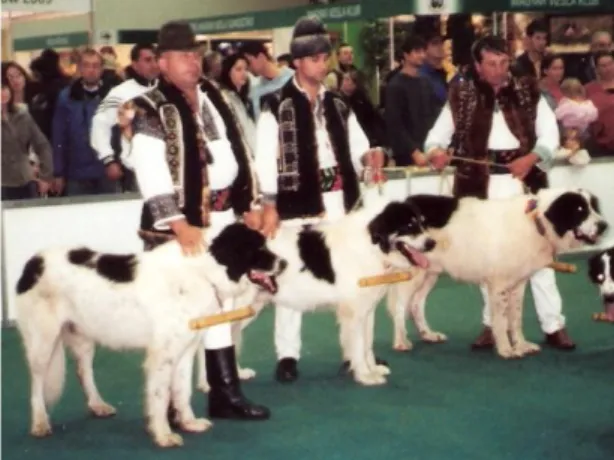DOI: 10.17707/AgricultForest.61.1.21
Orhan YILMAZ, Yakup Erdal ERTÜRK,
Füsun COŞKUN, Mehmet ERTUĞRUL 1
USING LIVESTOCK GUARDIAN DOGS IN BALKANS SUMMARY
Aim of this paper to review livestock guardian dogs in Balkan countries. Balkans consist of Albania, Bosnia and Herzegovina, Bulgaria, Croatia, Greece, Kosovo, Macedonia, Montenegro, Romania, Slovenia, Serbia, and Turkey. In Balkans there are quite successful livestock guardian dogs including Akbash Shepherd in (Turkey), Bucovina Shepherd (Romania), Bulgarian Shepherd (Bulgaria), Carpatin Shepherd (Romania), Greek Shepherd (Greece), Karabash (Kangal) Shepherd (Turkey), Karaman Shepherd (Turkey), Kars (Caucasian) Shepherd (Turkey), Karst Shepherd (Slovenia), Koyun Shepherd (Turkey), Macedonian Karaman Shepherd (Macedonia), Mioritic Sheep (Romania), Sharplaninac (Kosovo/Macedonia), Tornjak (Bosna-Herzegovinia). In Balkan countries are generally developing countries in which livestock production is still crucial in their economics. Moreover geography of Balkans are mainly mountainous and forest areas. In those areas there are some predators such as bear, fox, jackal, lynx, and wolf. Those conditions create that livestock guardian dogs are necessary for livestock production in Balkans.
Keywords: Canis familiaris, shepherd dog, native breed, genetic resource, agricultural economics.
INTRODUCTION
Dogs were the first species to be domesticated. In the world there are plenty of livestock guardian dogs (LGD) breeds which were differently created by local requirements. For example Pyrenees were developed for tractability around people but Tibetan Mastiffs were developed for hostility toward those not of their camp. The most LGD breeds fall somewhere in the middle (Cruz 2011). The common features of guardian dogs in this group are to become a large and powerful dog having whitish coat generally. The region of Balkan is located at the junction of Europe and Asia, therefore Balkans is a geographic bridge that
1
Orhan YILMAZ, (corresponding author: zileliorhan@gmail.com), Canakkale University, Faculty of Agriculture, Department of Animal Science, Canakkale, TURKEY, Yakup Erdal ERTÜRK, Igdir University, Faculty of Agriculture, Department of Agricultural Economics, Igdir, TURKEY, Füsun COġKUN, Ahi Evran University, Faculty of Agriculture, Department of Animal Science,
Kirsehir, TURKEY, Mehmet ERTUĞRUL, Ankara University, Faculty of Agriculture,
Department of Animal Science, Ankara, TURKEY.
Paper presented at the 5th International Scientific Agricultural Symposium "AGROSYM 2014". Notes: The authors declare that they have no conflicts of interest. Authorship Form signed online.
has been traversed by traders, travellers, treasure seekers and trespassers for thousands of years. It is thus also a cultural bridge imbued within the DNA of many civilizations (Yilmaz et al. 2012).
Aim of this paper is review livestock guardian dog breeds of Balkan countries.
MATERIAL AND METHODS
In Balkan countries of Albania, Bosnia and Herzegovina, Bulgaria, Croatia, Greece, Kosovo, Macedonia, Montenegro, Romania, Slovenia, Serbia, and Turkey there are about 15 LGD breeds including Akbash Shepherd, Bucovina Shepherd, Bulgarian Shepherd, Carpatin Shepherd, Greek Shepherd, Karabash (Kangal) Shepherd, Karaman Shepherd, Kars (Caucasian) Shepherd, Karst Shepherd, Koyun Shepherd, Macedonian Karaman Shepherd, Mioritic Sheep, Sharplaninac, and Tornjak (Yilmaz 2014). Following are the shepherd dog breeds well-known by respectful dog clubs across the world.
RESULTS AND DISCUSSION 1. Akbash Shepherd Dog
Figure 1. Akbash Shepherd Dog.
The Akbash Dog is a milky white livestock guardian breed native to the plains and mountains of the region between Eskisehir, Afyon, Konya, Salt Lake and Ankara of Turkey, which is its main spread. Even as the origins of the breed are unclear, it is known to be an ancient purebred and originated possibly from Middle Asia. In Turkey Akbash Dogs are owned and bred by villagers and shepherds to protect their flocks from wolves and other predators. Purebred Akbash Dogs are free of pinto, skewbald, and brindle markings or other indeterminate colours. The cream colour from ears to the tail end can be acceptable. It is more beautiful having a refined appearance with an edged muzzle and a softer coat with long and medium hair in comparison with the
Kangal Dog in fawn colour. Its weight and height at the withers are smaller than that of the fawn Kangal but it is as brave and faithful as the Kangal Dog, even more in fighting with predators. Its temperament is typified by a calm, quiet, alert, courageous independence coupled with a natural protective instinct. It is very agile. The Akbash Dogs can jump over the fences and walls in normal height of human. Possessing great stamina, they are capable of running at great speed (Kartay 2008, Yılmaz 2006, Yilmaz et al. 2012, Yilmaz 2014).
2. Bucovina Shepherd Dog
This breed is also called as Romanian Bukovina Sheepdog, Bucovina Sheepdog, Bucovina Shepherd, Southeastern European Shepherd, Dulau, Capau, Ciobanesc Romanesc de Bucovina, Ciobanesc de Bucovina, Bukovina Wolfdog, Bukovinac. Bucovina is raised in Carpatian Mountains in northeast of Romania. The main coat colour is white and the second colour might be brown or black. It has a large and wide head. Jaws are well developed. This breed is easy going, loyal and friendly against to children. Bucovina is used for protection of large and small ruminant herd and flocks. Shoulder height is 68-78 cm for male and 64-72 cm for females. Adult body weight is about 68-90 kg (Pugnetti 2001, Yilmaz 2014).
Figure 2. Bucovina Shepherd Dog.
3. Bulgarian Shepherd Dog
The Karakachan is a breed of dog that originated in Bulgaria as a mountain livestock guardian dog. Other names are Bulgarian Shepherd and Thracian Mollos. The dog is named after the Karakachans, Balkan Greek nomadic shepherds. Due to their conservative stock-breeding traditions, they have preserved some of the oldest breeds of domestic animals in Europe: the Karakachan sheep, Karakachan horse and the Karakachan dog. The Karakachan dog is one of Europe's oldest breeds. It is a typical Mollos, created for guarding its owner's flock and property; it does not hesitate to fight wolves or bears to defend its owner and his family in case of danger. Its ancestors started forming as early as the third millennium BC (Pugnetti 2001, Sedefchev 2005, Yılmaz 2006, Yilmaz 2014).
Figure 3. Bulgarian Shepherd Dog.
4. Carpatin Shepherd Dog
This breed is also called as Romanian Shepherd Dog, Ciobanesc Romanesc Carpatin, Romanian Carpathian Shepherd, Caine Ciobanesc Carpatian, Carpathian Sheepdog, Carpatin, Romanian Carpatin Herder, Rumanian Carpatin.. It is raised in Romania. The main coat colour is white, cream or fawn colour. When they are alert, they erect their tails. This breed is easy temper and stubborn. Some owners put a piece of wood on neck of the dog to prevent the dogs attack to human. Shoulder height is 61-66 cm and adult body weight is about 32-41 kg (Pugnetti 2001, Yılmaz 2006, Yilmaz 2014, Yilmaz et al. 2014).
Figure 4. Carpatin Shepherd Dog.
5. Greek Shepherd Dog
This breed is raised in Greece and also called as Greek Sheepdog, Ellinikos Poimenikos, Hellenikos Poimenikos, Greek Shepherd, and Standard Greek Sheepdog. It is raised in almost all regions of northern Greece. They resemble to Italian Maremma and Hungarian Kuvasz dogs. It is believed that this breed originally come from ancient Greek Civilizations. Coat colour is black, white, brown, light brown or spotted. Spotted dogs are mostly seen. This breed strong and muscled. Hind part of dog is wide and short. Legs are also muscled
and strong. Tail is normally pendant, but is erected when the dog is alert. Coat has double layer and prevent dogs from cold weather. Hair is longer in rear legs than other parts of body. It is a very successful livestock protection dog and it is also used as property protection. Shoulder height is 70-76 cm for male and 65-70 cm for females. Adult body weight is about 40-50 kg for male and 30-40 kg for female (Yılmaz 2006, Yilmaz 2014, Yilmaz et al. 2014).
Figure 5. Greek Shepherd Dog.
6. Karabash (Kangal) Shepherd Dog
It is believed that the Kangal (Karabash) dog is originated in Central Asia (Kirmizi 1994, Yilmaz 2007a, 2007b, Derbent and Yilmaz 2008, Yilmaz 2008) and is genetically distinct from other Turkish dogs (Koban 2001, Togan 2003, Altunok et al 2005).
Figure 6. Kangal (Karabash) Shepherd Dog.
The original name of Karabash (Dikmen 1936, Tellioglu 1973, Oncul 1983) means blackhead in Turkish and derives from the black muzzle. The Kangal can withstand the extremes of the cold harsh climate of its homeland. Courage, faithfulness and sensitivity are the foremost characteristics of the breed. It is a fearless and capable protector of its own flock, herd and its human family with whom it forms bonds yet it is a formidable fighter against large dogs and other predators (Pugnetti 2001, Kazak and Bakir 2002, Derbent and Yilmaz
2008, Yilmaz 2008). The Kangal has a strong, sturdy body with a black mask and muzzle and black around the ears and around eyes. The tail hangs low and has a slightly upward and forward curl (Gulec 1996, Galand 1997, Yesilyurt 1999, Kartay 2002, Yilmaz 2007a, 2007b). The true Kangal dog colour is solid dun or slightly paler shades of fawn or cream but never snow white („boz‟ in Turkish) (Robinson 1989, Yilmaz 2007a, 2007b). Colour is an important breed trait and in Turkey non-standard colours or patterns are indicators of outside blood (Yilmaz 2007a, 2007b, Derbent and Yilmaz 2008, Yilmaz 2008). The dense double coat is moderately short. Average mature live weights are 47.6 kg for males and 43.5 kg for females with shoulder heights of 75.9 cm for males and 73.3 cm for females (Yilmaz 2007a).
7. Karaman Shepherd Dog
This is a new type and has not been registered as a separate breed. This breed is raised in provinces of Aksaray, Karaman, and Konya. It is a local type. Although it resembles to Kangal (Karabash) dogs, Karaman dog has all coat colour varieties. Hence those two breeds can be close relative genetically. It has sturdy body and strong legs. Karaman dogs are resistible against to tough geographical conditions and limited care managements in this region (Yılmaz 2008, Yilmaz 2014, Yilmaz et al. 2014).
Figure 7. Karaman Shepherd Dog.
8. Kars (Caucasian) Shepherd Dog
It is a regional breed. Kars dog was first defined in 1996 (Nelson and Nelson 1996). It has several alternative local names including „killi‟ (shaggy) in Ardahan, Erzurum and Kars Provinces, „sacakli‟ (fringed) in Ardahan Province and „tuylu‟ (hairy) in Artvin Povince (Yilmaz 2008) and these localities are its main areas of distribution but it also extends to Agri, Erzurum and Igdir Provinces (Yılmaz and Ertugrul 2012a). Kars resembles the Caucasian Ovcharka (Mountain Dog). Its coat exhibits many colours and patterns. Colours include
black, reddish brown, agouti, grey, mixtures of black and brown, white, piebald and white with grey patches. White markings are very common in otherwise solid colour dogs. Also common are white forequarters, chests and neck collars. The head is usually dark. The usually long coat is important under severe winter conditions but when it is shed it gives the dog a dishevelled motley appearance. The hairs on the neck and the back of the hindquarters are long and this mane makes it appear larger from the front. The Kars is a somewhat smaller dog than either the Kangal or the Akbash with a mean weight of 44.6 kg and a mean height at the shoulder of 72.4 cm (Kirmizibayrak 2004). In general the Kars is a “one-man dog” but it an ideal courageous and faithful guard dog (Yilmaz 2006, 2007a, 2007b, 2008).
Figure 8. Kars (Caucasian) Shepherd Dog.
9. Karst Shepherd Dog
The other names of this breed are Istrian Shepherd Dog, North Istrian Sheepdog, Krasevec, Karst, Krasky Ovcar, Karst Mastiff, Krasevac, Krashki Ovtchar, and Istarski Krasevac. It is raised in Slovania and believed that it is originated from Central Asia. Coat colour is generally iron grey with dark shades. It is a medium-sized but strong dog.
Head is proportionally bigger that it is body. It has well developed teeth, almond shape chestnut or brown colour eyes and pendant ears. Tail is sword shape and extends to mid rear legs. They have about 14 cm waterproof and dense coat. It is a energetic and playful dog but it has not any tolerance against to either its master or herd. Average mature body weights are 26-40 kg with shoulder heights of 57-63 cm for males and 54-60 cm for females (Pugnetti 2001, Yılmaz 2006, Yilmaz 2014, Yilmaz et al. 2014).
10. Koyun Dog
Newly described (Yilmaz and Ertugrul 2012b) from Bayburt, Ordu, Rize, Trabzon Provinces on the eastern shore of the Black Sea in northeast Turkey. The Koyun is a flock and herd guardian dog. The dog is met in various colours but dark grey is the most common. Bi-coloured animals also occur. Koyun dogs have a solid body structure and strong legs which make for easy traverses of the hilly areas of the Canik Mountains where they are found. The tail is normally pendent but is raised in an alert posture up. Shoulder heights of dogs are about 70 cm and those of bitches about 1-2 cm lower. The Koyun is not a pet and in addition to guardian duties it assists its human owners in giving vociferous or even physical warning of the presence of intruding people or animals (Yılmaz and Ertugrul 2012b, Yilmaz 2014).
Figure 10. Koyun Dog.
11. Macedonian Karaman Shepherd Dog
This breed is also called as Black Macedonian Shepherd Dog, Makedonsko Ovcarsko Kuce Karaman, Makedonski Pastirski Pas Karaman, Karaman, Macedonian Karaman Sharplaninatz, Macedonian Karaman, Makedonski Ovcarski Pas, Karaman Sarplaninec, Makedonski Karaman, and Crni Makedonski Ovcar Karaman. This breed belongs to Macedonia. It is believed that this breed is a sub-type of Sharplanina Dog. Some scientist also claims that origin of this dog should be searched either in Iran or Turkey. The coat only has one colour which is black but some shades can also be seen from
dark brown or grey to black colour. Sometimes spotted colour is also seen. This breed is a typical mountain type dog. It has sturdy bones, muscled and strong body. Legs are also sturdy. Head is large and wide. Ears are generally cropped. Coat has medium-sized hair and it has also dense double layer of coat. This breed is famous with its courage and successfulness of livestock guarding. Even though it is a calm breed, it can be very agile when it needs. Shoulder height is about 70-72 cm (Pugnetti 2001, Yılmaz 2006, Yilmaz 2014).
Figure 11. Macedonian Karaman Shepherd Dog.
12. Mioritic Sheep Dog
Mioritic Sheep dog is also called as Ciobanesc Romanesc de Mioritic, Romanian Mioritic Sheepdog, Mocano, Barac, and Rumanian Barak. This breed belongs to Romania and it is believed that it is an ancient dog breed. Mioritic is generally raised in northern Molvaia and Bucovina regions. Coat colour is white or yellowish white.
Figure 12. Mioritic Sheep Dog.
Some yellowish white patches might be seen in hind part of the dog. It is robust and rugged-looking. Head is quite large. Muzzle is black and wide. It has
scissors bite. Eyes are medium-sized, oval shaped and in amber or hazel colour. Neck is muscled and medium-length. Tail is normally pendant but it is erected without curl when it is alert. Hair is long and dense. The length of hair is about 10-16 cm in head and legs. It has also dense and soft double layer. This breed is well-balanced and even-tempered. They are very aggressive in case of any intruder to their territory or masters. They are extremely patient against to children. Shoulder height is 70 cm for male and 65 cm for females. Adult body weight is about 40 kg (Pugnetti 2001, Yılmaz 2006, Yilmaz 2014).
13. Sharplaninac Dog
It has many names such as Yugoslavian Shepherd Dog, Yugoslavian Herder, Illyrian Sheepdog, Serbo-Macedonian Mountain Dog, Yugoslavian Mountain Dog, Sharplanina Shepherd Dog, Sharplaninatz, Ilirski Ovcharka Sharplaninatz, Sarplaninski Pas, Sarplaninski Ovcarski Pas, Mount Shara Mastiff, Jugoslovenski Planinski Pas, Yugoslovensko- Makedonski Pastirski pas-Sarplaninac, Crnogorski Planinski Pas- Sarplaninac, Srpsko-Crnogorski-Makedonski Sarplaninski Pas. The main raising area is Sharplaninac Mountains which extend between Kosovo and Macedonia. Hence this breed can be accepted as a Kosovo and Macedonia dog breed. Like other European dog breeds, it is believed that this breed originally come from the East in ancient times. It was first registered in 1930. Coat is light or dark iron grey. Some dogs have also some white patches. It has a robust bone structure medium-sized dog breed. It has a round head, strong jaws and teeth with rustic looking. Eyes are in black colour and almond shape. Ears are pendant. Tail is normally pendant but it is erected when it is alert. Hair is long and dense. The length of hair is about 10 cm. It has also dense and soft double layer. Sharplaninac is a fearless, intense, and energetic dog breed. It normally tend to bond to one master and it behave aggressively to other people. It is a perfect livestock guardian dog and can be struggle with wolves (Pugnetti 2001, Yılmaz 2006, Yilmaz 2014).
14. Tornjak Dog
This breed belongs to Bosnian and Herzegovina and is also called as Bosnian and Herzegovinian Shepherd Dog, Bosnian Shepherd Dog, Croatian Mountain Dog, Bosnian-Herzegovinian and Croatian Shepherd Dog, and Hrvatski Pas Planinac. It is believed that this breed is one the ancient LGD dog breed of the world. A document dated 9th century mentioned about Tornjak Dog. Although solid or bicolour are seen, the colour is generally white. It is a large, robust and square-shaped dog breed. Body parts are well-balanced. Is is an even-tempered, gentle and pleasant natured dog. This breed is very active in case of danger but it is not too aggressive. Shoulder height is 65-70 cm for male and 60-65 cm for females (Pugnetti 2001, Yılmaz 2006, Yilmaz 2014).
Figure 14. Tornjak Dog.
CONCLUSIONS
Generally LGDs have been known to struggle to the death with predators and in most cases predator attacks are prevented by a display of aggressiveness. LGDs are known to drive off predators that physically they would be no match for, such as bears and even lions. In the world there are some examples that LGDs allow sheep and cattle farming to coexist with predators in the same or nearby habitats. Apart from trapping and poisoning, LGDs seldom kill predators. Instead of killing, their aggressive behaviors tend to condition predators to seek unguarded prey. While doing this duty, LGDs are still important animal tool for livestock production in Balkans.
REFERENCES
Altunok, V. 2005. Genetic Evidence For The Distinctness of Kangal Dogs. Bull. Vet. Inst. Pulawy, 49: 249-254.
Cruz, C. 2011. Working dogs - What is their job? http://www.lgd.org/library.htm (accessed 04.01.2012)
Derbent, S. and Yilmaz, O. 2008. Le Chien Kangal. Öztepe Matbaası, Ankara.
Dikmen, C. F., 1936. SavaĢ ve Polis Köpeği. Türkiye Basımevi (War and Police Dog, Turkey Printhouse), 120 s., Ġstanbul.
Kartay, D. 2002. Step watcher of Kangal dog (Publication No 2922). Ministry of Culture Publishing: Ankara.
Kartay, D. 2008. Türk Çoban Köpeği AkbaĢ. Ġlya Ġzmir Basım Yayın (Turkish Akbash Shepherd Dog, Ilya Izmir Print and Publish), Ġzmir.
Kazak, Y. ve Bakır, B., (2002). Kangal Köpeği YetiĢtirici El Kitabı. TĠGEM UlaĢ Tarım ĠĢletmesi Müdürlüğü (Handbook of Kangal Dog Breeder's, TIGEM Ulas State Agricultural Management Directorate). Sivas.
Kırmızı, E., 1994. Türk Çoban Köpeğinin Tarihçesi. Türk Veteriner Hekimliği Dergisi, Cilt: 6, Sayı: 1: 39-41. Türk Veteriner Hekimleri Birliği Vakfı Yayınları (History of Turkish Shepherd Dog, Journal of Turkish Veterinary Medicine, Volume:6, Number:1, pages: 39-41, Publishing of Turkish Veterinary Medicine Union's Foundation). Ankara.
Kirmizibayrak, T. 2004. Some Morphological Characteristics Of Kars Dog. Turkish Journal of Veterinary and Animal Science 28: 351-353.
Koban E. 2001. Genetic identity of Anatolian shepherd dog (ASD) population using microsatellites. (Unpublished Msc.Thesis). Middle East Technical University: Ankara.
Nelson, D.D. and Nelson J.N. 1996. A general classification of the shepherd dogs of Turkey. In: Tekinsen C and Tepeli C (eds) International Symposium on Turkish Shepherd Dogs, 23 October 1996, Konya. Veterinary Print Unit, University of Seljuk: Konya, Turkey. 19-97.
Öncül, O., 1983. Sadık Dostumuz Köpekler Ailesi. Dönmez Ofset (Our Loyal Friend of Dog Family, Donmez Printhouse). Ankara.
Pugnetti, G., (2001). Köpek Ansiklopedisi. ArkadaĢ Yayınevi (Dog Encyclopedia, Arkadas Printhouse). Ġstanbul.
Robinson, R. 1989. Inheritance of Coat Colour in the Anatolian Shepherd dog. Genetica 79: 143-145.
Sedefchev, S. 2005. The Karakachan Dog – Continuation of anOld Bulgarian Tradition.Carnivore Damage Prevention News, 9: 14-18.
Tellioğlu, S., 1973. TanınmıĢ Köpek Irkları Ve Özellikleri. Atatürk Üniversitesi Yayım Müdürlüğü Çiftçi BroĢürleri No: 18 Atatürk Üniversitesi Basımevi (Wellknown Dog Breeds and Traits. Ataturk University Publishing, Farmer Brochures). Erzurum. Togan, I. 2003. Employment Of Some Molecular Techniques To Answer Some
Questions And Problems Related With Kangal Dog. First International Kangal Dog Symposium, 11 July 2003, Kangal, Sivas. Devran Printhouse: Ankara. 83-88.
Yesilyurt, H. 1999. Kangal Coban Kopegi Tanitim El Kitabi, Kangal Kaymakamligi. (The handbook of Kangal shepherd dog. Governership of Kangal County: Sivas, Turkey.
Yılmaz, O. 2006. Sürü Koruma Köpekleri, YayımlanmamıĢ Doktora Semineri. Ankara Üniversitesi, Fen Bilimleri Enstitüsü (Flock Guardian Dogs, Unpublished PhD Seminar, Ankara University, Institute of Science and Technology), Ankara.
Yılmaz, O. 2007a. Türkiye‟nin ÇeĢitli Bölgelerinde YetiĢtirilmekte Olan Kangal Köpeklerinin Bazı Morfolojik Özellikleri (YayımlanmamıĢ Doktora Tezi). Ankara Üniversitesi, Fen Bilimleri Enstitüsü (Some Morphological Traits of Kangal Dogs Raised in Some Part of Turkey. Unpublished PhD Seminar, Ankara University, Institute of Science and Technology), Ankara.
Yılmaz, O. 2007b. Turkish Kangal (Karabash) Shepherd Dog. Impress Printing, Ankara. Yilmaz, O. 2008. Turk Kangal (Karabas) Coban Kopegi. Bilge Kultur Sanat Yayinevi:
Yılmaz, O. ve Ertugrul, M. 2012a. Determination of Kars Shepherd Dog raised in Turkey. Canadian Journal of Pure and Applied Science. 6(3): 2127-2130.
Yılmaz, O. and Ertugrul M. 2012b. Determination of the Rize Koyun (Sheep) Dog in Turkey. Canadian Journal of Applied Sciences, 2(1): 216-221.
Yılmaz, O., Ertugrul, M. and Wilson R. T. 2012. The domestic livestock resources of Turkey: breed descriptions and status of guard and hunting dogs. 63rdAnnual Meeting of the EAAP, 27-31 August 2012, Bratislava, Slovakia.
Yılmaz, O. 2014. Dünya Çoban Köpeği Irkları. Veni, Vidi Vici Yayınları (World Shepherd Dog Breds. Veni Vidi Vici Publishings), Zile.
Yılmaz, O, CoĢkun, F. ve Ertuğrul, M. 2014. A Short Review: Large Carnivore Damage Pressure on Extensive Grazing Livestock in Europe. Carnivore Damage Prevention News, 1 (2): 23-28.
